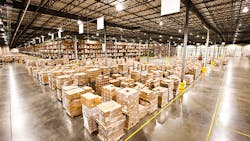E-commerce Fueling New Projects in Major Logistics Hubs
The interdependence among the economies of the United States, Canada and Mexico reflect in how closely their markets are trending, with key sectors like e-commerce, manufacturing, technology and energy fueling progress across the board, according to Cushman & Wakefield’s newly released 2015-2017 Industrial Real Estate Forecast.
“Strengthening fundamentals throughout North America support a positive forecast for the next three years,” said Maria T. Sicola, who heads the commercial real estate services firm’s Research for the Americas group. “We expect economic conditions to drive further improvement and growth in the industrial real estate sector.”
E-commerce is fueling new projects in major logistics hubs such as Dallas/Fort Worth, the Inland Empire, Chicago and Atlanta. Retailers are now utilizing distribution centers for fulfillment as well. And instead of fulfilling web orders from hundreds of miles away, retailers like Walmart, Best Buy and Gap are routing orders to nearby outlets. Online Business-to-Business (B2B) transactions are also on the rise—a 2014 Forrester Research study found that 89% of B2B providers have added e-commerce to their business, increasing annual revenue by a combined 55%.
And while trucks remain the primary shipping method, rail is rapidly emerging as an alternative. Markets with intermodal capabilities, notably Dallas/Fort Worth, Atlanta and Chicago are leading the way in rent growth, absorption and construction, and the trend is filtering down to such other markets as Indianapolis and Kansas City.
Overall, the warehouse sector has posted 19 consecutive quarters of declining vacancies, now standing at 6.7% nationally. Even with considerable new construction, the vacancy rate is projected to decrease to 6.3% in 2015.
With regard to manufacturing, activity is on the rise and expected to post steady increases. Less expensive energy at home and rising labor costs abroad have resulted in bringing manufacturing back home. As a result, 38.8 million square feet of manufacturing space was leased in 2014, and large build-to-suit projects are currently underway in Atlanta, Denver and Chicago. With manufacturers responding more quickly to local market demands, regional manufacturing will increasingly be seen as cost effective.
Driving new supply in 2014—the highest level in six years—is technology. Notably, Silicon Valley out-performed other regions in space absorbed over the past three years and is expected to remain on top, accounting for 18% of national absorption in 2015-2017. Other top performers are Boston, driven by technology, pharmaceuticals and life sciences; Denver (energy and aerospace); and Dallas (energy and technology). The three are predicted to absorb a combined 4.8 million square feet in 2015-2017. Portland is among the markets expected to experience positive momentum in the near term, owing to tame supply pipelines and economic expansion.
